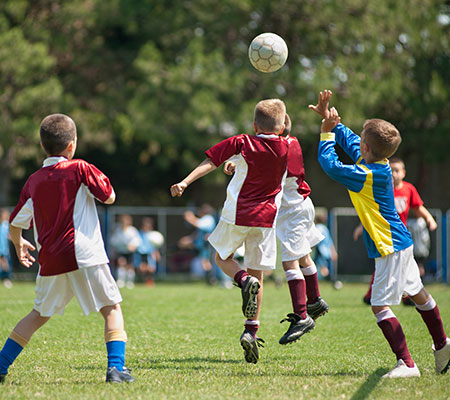
Youth soccer rules limit heading for players 13 and younger because of possible concussion risk.
A concussion can happen when someone’s head strikes an object such as another player or the ground while playing sports.
In soccer, players purposely make head-to-object contact when they head the soccer ball.
“Heading puts you in a position to accidentally collide with another player, which is known to cause concussions,” said Chris Orgeman, a Marshfield Clinic athletic trainer.
Heading the ball improperly, like when a player doesn’t have enough time to react, also can cause a concussion. However, scientists are still learning how heading the ball properly affects concussion risk.
A link between heading and concussions
Two recent studies have looked at the connection between soccer heading and concussions. One study looked at the brains of deceased soccer players who had been skilled at heading. Some of their brains showed signs of chronic traumatic encephalopathy, or CTE, a progressive degenerative disease found in people who had repeated concussions.
Another study of living players showed those who did a lot of heading were three times more likely to have concussion symptoms than those who didn’t often head the ball.
“The studies show a connection between heading and concussions but we still need more information and research,” Orgeman said. “It’s been part of the game forever and we don’t want to jump to conclusions.”
Rules limit heading in youth soccer
U.S. Club Soccer released heading rules to reduce concussion risk for young athletes.
Players under age 11 aren’t allowed to head the ball at all in practice or games. Players ages 12-13 must limit their heading practice to no more than 30 minutes and 15-20 headers per week.
The rules aren’t required for all youth soccer leagues, but Orgeman said other leagues should consider limiting headers to a certain number per week for younger players.
The WIAA doesn’t limit heading for high school players.
Watch for concussion signs
Coaches and referees are trained to recognize concussion signs, but parents also should know the symptoms. Headache, dizziness, weakness, confusion and vision changes after impact to the head signal concussion.
Concussion signs may not appear until a few hours after the injury, and children may not let you know they have symptoms.
Ask your child about signs of concussion after heading the soccer ball in practice or games. Let your child’s coach know if symptoms develop and have the child checked by the school’s athletic trainer.
“The biggest risk for someone with a concussion is to continue playing,” Orgeman said. “The brain is vulnerable to a worse concussion and second impact syndrome until it’s healed.”
Related Shine365 stories
How to recognize kids’ concussion symptoms

